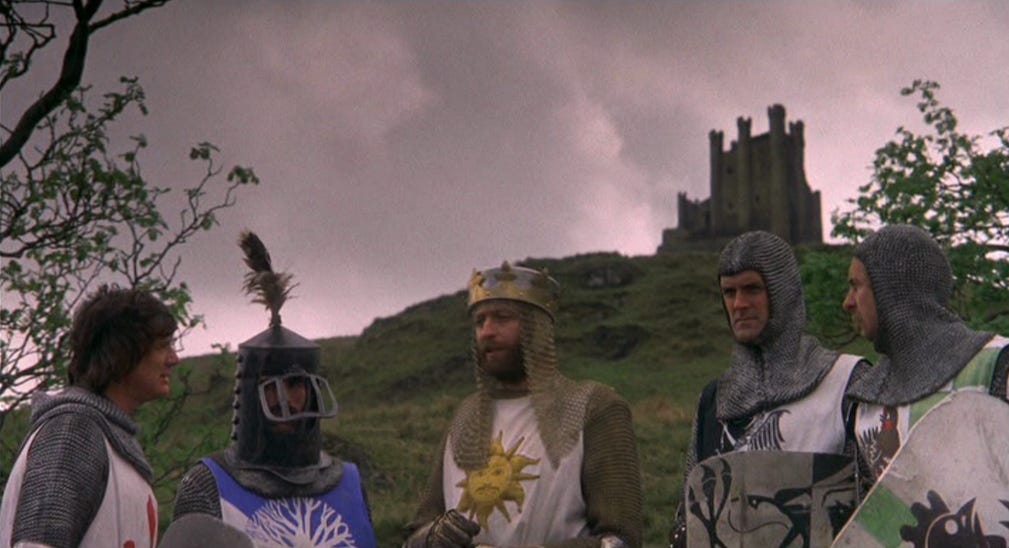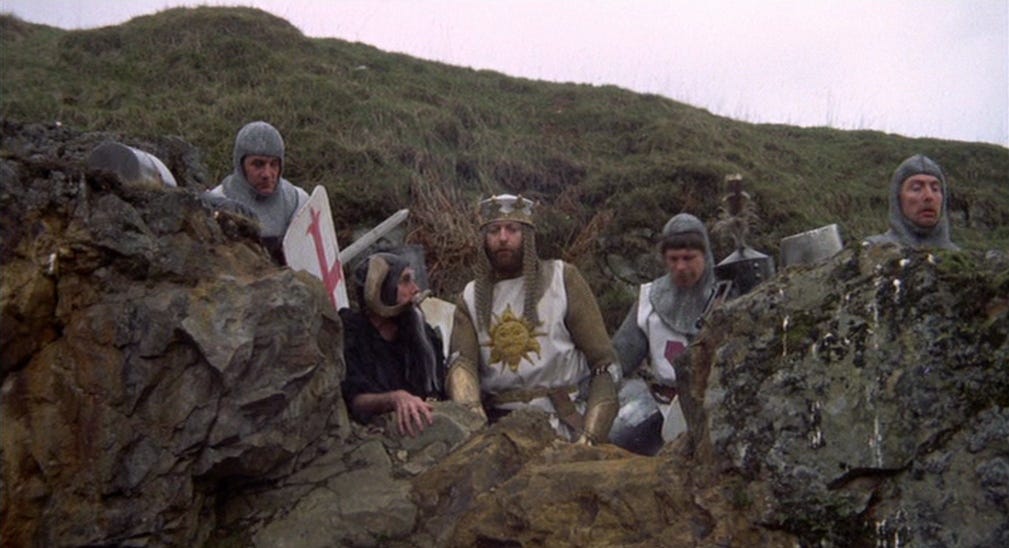Review: "Monty Python and the Holy Grail" turns 50, and the laughs keep coming
Movie of the Week #31 isn't dead yet
Welcome to Movie of the Week, a Wednesday column where we take a look back at a classic, obscure, or otherwise interesting movie, with writing of mine that’s never been published online before. This week, we’re celebrating a movie that came out almost exactly 50 years ago today, on April 3rd, 1975. Enjoy…
Monty Python and the Holy Grail
1975, Dir. Terry Gilliam & Terry Jones
Originally written in 2014, unpublished until the book 200 Reviews in 2023
Watching Monty Python and the Holy Grail for the...well, I’ve lost track of how many times I’ve seen it, actually, having fallen in love with the film so long ago, at an age too young to fully understand it, but fully capable of being inspired by its boundless, lunatic imagination.
In any case, watching Monty Python and the Holy Grail for the however-many-times-I’ve-seen-it time, I am struck by the sheer amount of transcendent, classic comedy it contains. A succession of individual comedic miracles – bits large or small that are universally inspired in their wit, creativity, and devilish devotion to silliness – that combine to create a literally non-stop hilarious whole, the film is that rarest of beasts: A comedy in which every joke lands, each bit is flawlessly written and performed, and nearly every scene, line, and even vocal inflection has become wildly iconic. It is like an album composed entirely of incredible songs, one right after the other – you look at it and wonder how such sustained greatness can exist in a single artistic package (or you would wonder this, it might be more accurate to say, if you weren’t too busy laughing).
So we start with a scene that any person worth knowing can quote in part or in full – “What? A swallow carrying a coconut?” – and are amazed to discover, especially on subsequent viewings, that this riotous back-and-forth about the minutiae of swallows and coconuts is far from the best gag in the film. I would put the witch-burning scene – and the ridiculous but surprisingly sound employment of scientific method it contains – above that one, alongside King Arthur’s one-sided argument with the politically conscious peasant Dennis, Sir Galahad’s increasingly surreal temptations at Castle Anthrax, the ridiculous perfection that is the Knights Who Say Ni!, the encounter with Tim the Enchanter and the ferocious Killer Rabbit, the use of the Holy Hand Grenade of Antioch, the sudden death of the animator in the cave, and the passage over the Bridge of Death. The Tale of Sir Lancelot, which not only includes the eponymous Knight’s bloody raid of Swamp Castle, but the incredible comic wordplay of the gruff father trying to give instructions to two dim-witted guards, stands tall above all these sequences for me.
Any of these scenes, and many more that have gone unmentioned, could be the glorious centerpiece of a different, lesser comedy – a film we might still deem classic for that single scene’s presence. But Monty Python and the Holy Grail has all of them, lined up in a row, their loose and sometimes confusing arrangement (especially as the film nears its wonderfully truncated finale) only enhancing the strange, surreal comic weight of the picture.
I wonder, whenever I watch the film, how contemporary audiences in 1975 reacted to the singular silliness of the piece. Even for those who had been familiar with Monty Python on television, it is still possible Holy Grail may have come as something a shock – a pleasant and amusing one, most likely – for the sheer concentration and density of its ridiculousness. The Pythons had certainly established their own genius brand of absurdity on television – where their chief breakthrough, I would argue, was their ability to wrangle the silliest of silly ideas into straight-faced, workable, comically tight sketches – but Holy Grail was something new (if not, as John Cleese would say, something completely different). Where the show was sketch-based, the Pythons firing their comedic sensibilities across a wide range of set-ups and targets, Holy Grail funneled all that lunatic energy into one setting, time, and place, with one central set of characters. The exact same comic sensibilities are on display, but when contained in one Arthurian setting, the Pythons were able to build jokes and character details upon one another in ways they hadn’t before, letting the zaniness snowball to increasingly intense levels of comedy.
The DNA of the sketch format is obvious in the film’s haphazard construction, of course, but it should not be taken for granted that the Pythons were able to apply their creative and surprising comedy ethos to a full-length narrative feature – many films that have come after, made by comedians moving from sketch humor or stand-up into filmmaking, have floundered, and while this brand of sustained, long-form silliness can be utterly blissful when done well – Adam McKay’s Anchorman movies are good modern examples – this sort of tone often isn’t workable in feature filmmaking. The Pythons did it right, though, and they would repeat the trick a second time with 1979’s Life of Brian, which saw the return of the Python’s sharp satirical edge, mostly absent in the purely farcical Holy Grail (this is one of the core reasons why Life of Brian, piercing and incisive, is the better film, while Holy Grail, unceasingly funny, is the better comedy).
That the production was plagued with budgetary limitations, practical difficulties, and directorial disagreements between Terry Jones and Terry Gilliam is, in some ways, a surprise, given what a remarkably pure outpouring of creative energy and comic license the finished product feels like. Each of the six Pythons is used at their absolute best in the feature – Chapman as the most forcefully funny of straight men, Jones for his wonderfully endearing dim-witted creations, Cleese as the comically commanding leading man (or, in the case of Tim the Enchanter, character actor) gone too far, Idle for his particular brand of gleeful comic timing, Gilliam for his hilarious animations and excellent background presence as Patsy, and Palin as the scene-stealing jack-of-all-trades – and each and every scenario that arose from budget problems was turned into terrific comedy. The supplanting of coconuts for horses may be the most iconic and beloved gag ever created to compensate for lack of funds, but the shockingly abrupt ending (which grows on me every time) is just as creative a way around an insufficient budget, while the technically terrible, slapdash camerawork (particularly when it is used for depicting action or building atmosphere) is consistently good for a couple of laughs.
Watching Holy Grail, one wonders if there is entirely too much money in cinematic comedy today. Would there be more creativity on display if more comic filmmakers were forced to realize their visions for pittances? Or, to put it another way – if the Pythons were backed by a major studio and had $50 million to work with, is there any chance the film’s most fearsome threat would be a innocuous white rabbit? Or that the chase sequence in the caves would be A) animated, and B) resolved by the sudden death of the animator? These are jokes one comes up with when one has only the most modest of tools at one’s disposal, and yet, they are some of the most indelible gags ever committed to celluloid.
Great comedy comes in many varied shapes and forms, and even 39 years later, so much of Monty Python and the Holy Grail looks utterly unique. Even in the Python’s extended oeuvre, there is nothing quite like it, and no matter how many times one hears its dialogue parroted by fans, the film itself feels fresh, as energetic, vibrant, and inspired as it must have seemed back in 1975.
NEXT TIME: We take a look at the best Batman movie ever made, the 1993 animated classic BATMAN: MASK OF THE PHANTASM.
Read the book 200 Reviews by Jonathan R. Lack in Paperback or on Kindle
Subscribe to PURELY ACADEMIC, our monthly variety podcast about movies, video games, TV, and more
Like anime? Listen to the podcast I host with Sean Chapman, JAPANIMATION STATION, where we review all sorts of anime every week. Watch on YouTube or Subscribe wherever you get your podcasts.




